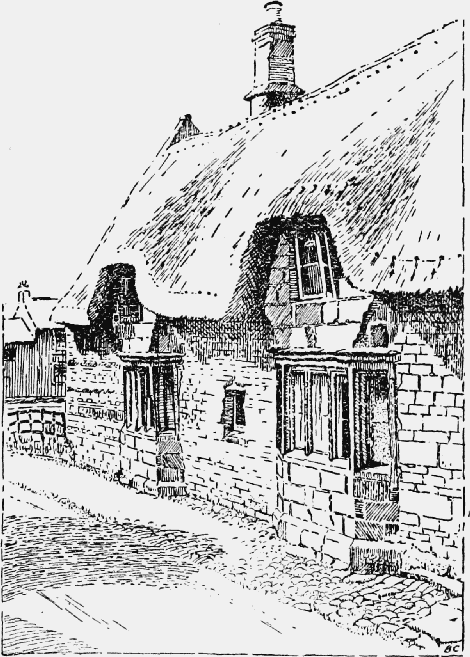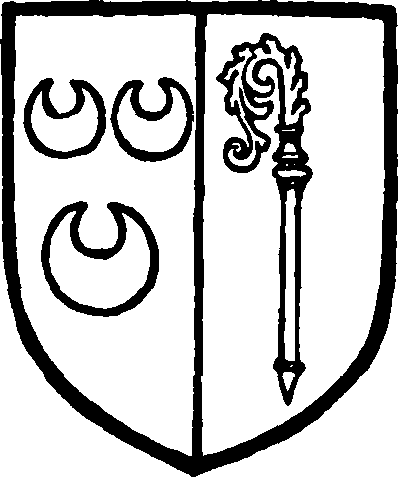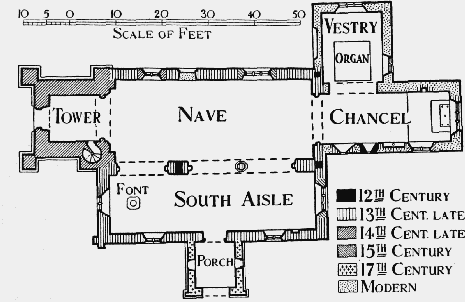A History of the County of Rutland: Volume 2. Originally published by Victoria County History, London, 1935.
This free content was digitised by double rekeying. All rights reserved.
'Parishes: Caldecott', in A History of the County of Rutland: Volume 2, ed. William Page( London, 1935), British History Online https://prod.british-history.ac.uk/vch/rutland/vol2/pp179-182 [accessed 8 January 2025].
'Parishes: Caldecott', in A History of the County of Rutland: Volume 2. Edited by William Page( London, 1935), British History Online, accessed January 8, 2025, https://prod.british-history.ac.uk/vch/rutland/vol2/pp179-182.
"Parishes: Caldecott". A History of the County of Rutland: Volume 2. Ed. William Page(London, 1935), , British History Online. Web. 8 January 2025. https://prod.british-history.ac.uk/vch/rutland/vol2/pp179-182.
In this section
CALDECOTT
Calcot, Calcoote, Caldecote (xvi-xvii cent.).
The parish of Caldecott covers 1,162 acres of clay and loam land given up wholly to grazing. The ground falls from the north, where it is over 300 ft. above the Ordnance datum, to 170 ft. in the south, where the parish and county boundary is formed by the Eye Brook and River Welland.
The village is about 4½ miles from Uppingham on the road to Kettering. It is approached from the south over the Eye Brook by a stone bridge with brick parapets, to the west of which is the mill, now disused. In a will of 1615 mention is made of 'the milles of Caldecott.' (fn. 1) The church is on the north side of the village. Most of the houses are built of local ironstone; one in the main street, with thatched roof, has a panel inscribed 'd.h. 1646'; and another at the east end of the village, with good four-centred doorway, is dated 1647. Near the church is a house with panel inscribed 'R C E 1684,' and a cottage adjoining the churchyard is dated 1729. Two other houses have panels inscribed respectively 'w.w. 1774' and 'I E B 1789,' and there are several 17th- and 18th-century undated houses, some with mullioned windows, but in most cases wooden windows have been introduced. A cross formerly stood at the top of the village where the three roads meet. Another cross at one time stood on the Green, which is still known as Cross Bank. The base of this cross survived and was locally called the 'King Stone,' but it was dug up a little while ago and used for quoins for a wall in Black Horse Lane. (fn. 2) The stocks are said to have vanished about 1835. (fn. 3)
The vicarage of Liddington-cum-Caldecott is about a quarter of a mile north of the church and has a lodge on the Kettering road. The old vicarage of Caldecott is described in 1742 as a building of three bays with a yard of half a rood, which was then divided into two tenements. (fn. 4)

Caldecott: An Old House
The nearest railway station is Rockingham, a quarter of a mile to the south.
In 1639 Robert Rudd, vicar of Liddington-cum Caldecott, was defendant in a suit promoted by Peter Woodcock, grazier, in the Court of High Commission. It is stated in the sentence that Rudd had been vicar of Caldecott 40 years and for sundry years had omitted to read divine service at Caldecott; he neglected to wear a surplice, but only a threadbare coat with four skirts; he busied himself with sordid employment and served a thatcher with straw; he preached at Caldecott that Nebuchadnezzar was a great grazier and did eat grass like an ox and died like an ass, like divers graziers then did, referring, as was thought, to Peter Woodcock, a grazier of the parish; he refused on Palm Sunday to administer the Communion to some forty parishioners, and at other times, although having sufficient wine, he used to draw away the cup from the communicants. The court ordered that he should be suspended and another minister be put in charge at a stipend to be paid out of the vicarage, and further he should pay a fine of £100 and make public submission. (fn. 5)
Manors
CALDECOTT was entered in the Domesday Survey as pertaining to two hides in Liddington (q.v.) held of the Bishop of Lincoln. The two manors are still held together and have shared the same history. In 1246 a grant was made to the Hospitallers of free warren in their demesne lands in Caldecott. (fn. 6)

Pipewell Abbey. Party argent three crescents gules and azure a crozier erect or.
Lands worth 18s. in Caldecott were returned in 1537 as held with lands worth 2s. in Halyoke (co. Leic.) by the monastery of Pipewell (fn. 7) (co. Northants.). In 1553 a grant of 5 acres of meadow lying upon Welland within the fields of Caldecott in Liddington parish, late belonging to Pipewell Monastery, and in the tenure of William Conyers, was made to Anthony Williams and John Conyers. (fn. 8)
It is said that the custom of Borough English prevails in the manor. (fn. 9)
SNELSON (Smelestone, xi cent.) appears in the Domesday Survey (1086) and again in 1286 and 1316 as held with Liddington (q.v.) by the Bishops of Lincoln. It is now lost, but must have formed, with Stoke Dry and Caldecott, part of the block of episcopal property at the south end of the county, of which it was perhaps the southernmost. In a grant of the prebendal house in Liddington in 1650 there is reference to Snelson's Field among the lands in Caldecott held with that house. (fn. 10) The manor of Snelston (Snelleston), held in 1243 by Emma de la Legh in dower, reverted at her death to John de Gray, (fn. 11) who held Whitwells Manor in Ketton (q.v.).
Church
The church of ST. JOHN THE EVANGELIST consists of chancel 27 ft. by 11 ft., with organ-chamber and vestry on the north side, clearstoried nave 43 ft. 10 in. by 17 ft., south aisle 12 ft. 3 in. wide, south porch, and west tower 10 ft. square, all these measurements being internal. The tower is surmounted by a spire. The width across nave and aisle is 32 ft.
The church was restored and the chancel rebuilt in 1865, (fn. 12) and in 1908 the organ-chamber was added. The chancel is built of coursed local ironstone and has an eaved roof of Collyweston slates, but it retains most of its ancient features. With the exception of the porch, which is of ashlar, the rest of the fabric is of ironstone rubble with modern tiled roofs; the aisle has a plain parapet, but the nave roof is eaved. The porch, which dates from 1648, is covered with stone slates. Except at the west end of the nave, all the walls are plastered internally.
The first church was an aisleless building with short square-ended chancel, the extent of which is represented by the two eastern bays of the present nave and the western part of the chancel, probably dating from the early part of the 12th century. (fn. 13) There is a small round-headed window of this period, with wide inner splay, in the south wall of the chancel, approximately in its original position, but its jambstones have been misplaced. (fn. 14) West of this is a tall lancet opening with transom, forming a lowside window. This belongs to alterations, amounting almost to a rebuilding, made towards the end of the 13th century, when the chancel was lengthened and remodelled and an aisle was thrown out on the south side of the nave, the length of which was increased westward by the addition of a bay. This is shown by a break in the arcade between the second and third bays from the east, where there is a masonry pier with respond on each face, representing the position of the early west wall, which probably remained standing till the new work was completed. This would be c. 1280–1300, to which period the chancel arch, the nave arcade, and the aisle belong, together with such original features of the chancel as were retained at the rebuilding.
The east window is of three lights with uncusped intersecting tracery and continuous roll moulding to the rear-arch and jambs. Below the window, at the back of the altar, is a large rectangular chamfered recess probably for a reliquary, and in the south wall a shouldered piscina the bowl of which is gone, and two stepped sedilia with chamfered arches and dividing shaft with moulded capital and base. There is a rectangular aumbry in the north wall. The lowside lancet splays internally to 5 ft. Above the piscina is a late 14th-century square-headed window of two trefoiled lights, but there are no windows on the north side. The chancel arch is of two chamfered orders and hood-mould on the east side only, the inner order on half-octagonal responds with moulded capitals and bases, and the outer continued to the ground. (fn. 15) Immediately south of the arch, in the eastern part of the south wall of the nave, is the doorway to the rood-loft, with plain pointed chamfered head; it opens on to a fragment of beam, perhaps the first joist of the loft floor. Four steps of the roodstair remain in the thickness of the wall, 5 ft. above the floor. (fn. 16)
The two eastern arches of the nave arcade are of two chamfered orders on half-octagonal responds and octagonal dividing pillar, all with rather heavy moulded capitals and responds. The western arch is of similar character, but is lower at the springing. (fn. 17) In the south wall of the aisle are two good pointed twolight windows with quatrefoils in the heads, and a large moulded piscina, (fn. 18) the bowl and hood-mould of which are mutilated. There is an image bracket in the east wall south of the window, but the window itself is a late 15thcentury insertion of three cinquefoiled lights and fourcentred head. The west window of the aisle appears originally to have been like those in the south wall, but was altered in the 17th century and has now a plain square head. The pointed south doorway is of two continuous hollow chamfered orders, with hood-mould, and the blocked north doorway is of similar character but with three hollow chamfers. The north wall of the nave is pierced by two later openings, that at the west a two-light pointed window of late 14th-century date, the other a late 15thcentury three-light window with four-centred head.
Towards the end of the 14th century the tower and spire were erected, and the clearstory was added in the 15th century, the north wall of the nave being then heightened. The tower is of three stages, marked by strings, with moulded plinth and large clasping buttresses to the lower stage, above which they are taken up to about a third of the height of the bell-chamber in diagonal form. There is a projecting vice in the south-east angle. The pointed west window is of two trefoiled lights similar to the contemporary window on the north side of the nave, but the four-centred doorway is a late 15th-century insertion, with continuous hollow moulded jambs and head. The pointed bell-chamber windows are of two trefoiled lights with quatrefoil in the head, and the tower terminates in an embattled parapet with a grotesque gargoyle at each angle. The arch opening to the nave is of two continuous chamfered orders without hood-mould. The spire was struck by lightning on 30 July 1797, (fn. 19) and was afterwards rebuilt in Weldon stone. (fn. 20) It is twice banded and has plain angles and two tiers of gabled lights on the cardinal faces. On the south side, halfway between the lights, is the date 1638, (fn. 21) and on the top portion 1797.

Plan of Caldecott Church
The clearstory has three four-centred windows of two trefoiled lights on the south side, but the easternmost only is ancient; on the north side there are two windows, placed immediately over those in the wall below, the easternmost old and of three lights, the other a copy of those on the south side, inserted in 1865. (fn. 22) The tabling of the former low-pitched nave roof remains on the west wall, the present highpitched roof and its gable being modern. A 15thcentury sanctus bell-cote has been rebuilt. (fn. 23)
The porch has a round-arched outer doorway of two chamfered orders on moulded imposts, wooden benches, and small square-headed side windows In the gable is a panel with the date '1648.' (fn. 24)
The late 13th-century font has a rectangular bowl with slightly sloping sides, each carved with a trefoiled arch, and chamfered angles on which various geometrical patterns are incised. It stands on a cylindrical stem and is on four legs, the moulded capitals and bases of which alone remain unaltered, the shafts having been turned in a lathe by a former churchwarden. (fn. 25) The pulpit (fn. 26) and all the fittings are modern. (fn. 27) There was formerly a painting of the Temptation in Eden on the north wall of the nave. (fn. 28)
The only old mural monument, to Anne the wife of William Goodman (d. 1712), is now in the vestry, where is kept a chest inscribed 'r.d. 1724.' There is a War Memorial tablet (1914–19) in the nave. The Royal Arms of Queen Victoria are under the tower.
There is a ring of five bells cast in 1696 by Toby Norris (II) of Stamford. (fn. 29)
The plate consists of a cup and cover paten of 1637–8, with the maker's mark d.g. (fn. 30)
The registers before 1812 are as follows: (i) all entries 1605–1724; (ii) baptisms 1725–83, marriages 1725–54, burials 1725–70; (iii) baptisms and burials 1783–1812; (iv) marriages 1755–1812. There are churchwardens' accounts from 1807.
Advowson
Caldecott is a chapelry annexed to the Vicarage of Liddington (q.v.). Under the Commonwealth an augmentation of the stipend of the minister of Caldecott of £31 a year was ordered which was approved in 1656. (fn. 31)
There are no charities in this parish.
